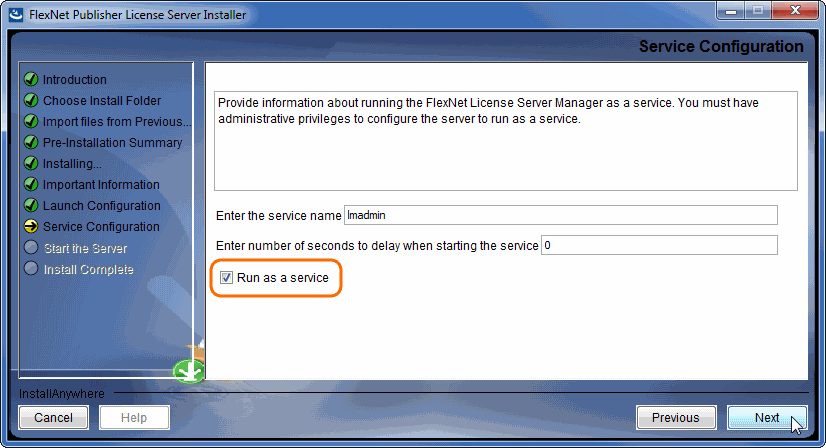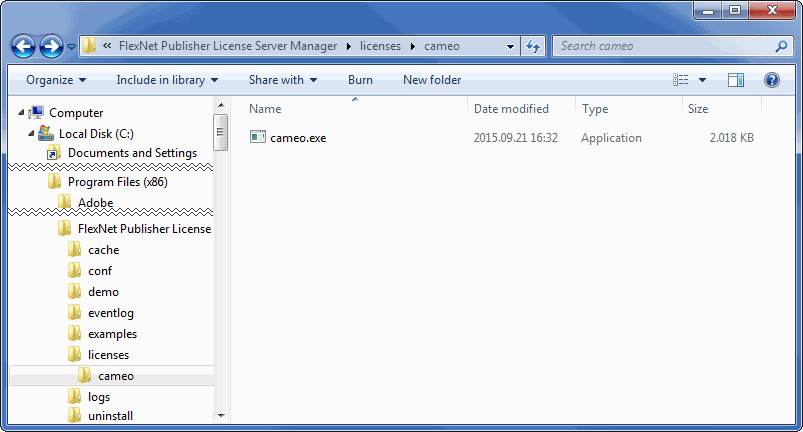On this page
Related resources
Choosing the Flexnet server manager
There are three types of the FlexNet server managers.
- lmadmin – a web-based license server manager with GUI (recommended).
- lmgrd – a license server manager with a command-line interface.
- lmtools – the old Windows based server manager (replaced by lmadmin).
We recommend using lmadmin.
- lmadmin installer comes only in 32 bit architecture (regardless of the version)
- 11.17 version license tools are not available in 64 bit binaries only 32 bit tools are available (additional 32bit libraries need to be installed in the 64bit multi-arch system to execute them)
Prerequisites
- You have the license owner account credentials.
If your operating system is Windows:
To use lmadmin on Windows platforms, the Microsoft Visual C++ 2013 Redistributable Package must be
installed. You have an option to install this package during the FlexNet Publisher License Server Installer process.
- You can run lmadmin (11.17.0) on officially supported platforms:
Windows 10
Windows Server 2008, including SP1, SP2, and R2
- Windows 8
- Windows 8.1
- Windows 7, including SP1
- Windows Server 2012 R2
- Windows Server 2012
- You can run lmadmin (11.17.0) on officially supported platforms:
For 32bit systems it is recommended to use 32 bit lmadmin or 32 bit lmgrd, with 32 bit cameo daemon vendor file.
For 64bit systems it is recommended to use 32 bit lmadmin (additional 32bit libraries need to be installed in the 64bit multi-arch system to execute them).
- If your operating system is Linux:
- You have to have glibc libraries installed corresponding to your operating system architecture.
You have to create a non-root system user with root privileges and install/run the server tools using it:
This can be achieved either by:
1. Adding the user to the 'sudo' group
2. Editing the file /etc/sudoers using visudo.
Method 1 (Ubuntu based):
sudo adduser newuser sudo usermod -aG sudo newuser
Method 2 (Ubuntu based):
Modify '/etc/sudoers' with the editor "visudo". #Create a user called "newuser" [root@mylinux~]#useradd newuser [root@mylinux~]#passwd newuser #Edit the file with visudo: [root@mylinux~]# visudo #Find a line 'User privilege specification' and add the following. newuser ALL=(ALL) ALL
Method 1 (Redhat/Fedora/CentOS)
sudo adduser newuser sudo passwd newuser sudo usermod -aG wheel newuser
- If your operating system is 32 bit Linux:
- It is recommended to use 32 bit lmadmin installer, or 32 bit lmgrd
You have to install the Linux Standard Base (LSB) library.
For Ubuntu:
sudo apt-get install lsb-core
For Redhat/CentOS/Fedora:
sudo yum install redhat-lsb-core
If your operating system is 64 bit Linux:
For version 11.17.0 we recommend 32 bit lmadmin installer. Alternatively, you can use 64bit lmgrd of version 11.12.1. Learn more about 11.12.1 installation >>
Check if LSB was installed successfully using:
lsb_release -a
In order to query which lsb library is required for a particular Centos version, the following command can be executed:
sudo yum provides /lib/ld-lsb.so.3
It is a best practice to run license servers on a server based OS.
FlexNet License Administration Guide by Flexera Software, Inc
For more information about FlexNet, see:
Installation procedure
Download the FlexNet server installer from our website.
Log in with license owner credentials, if prompted.
Install the server manager.
We highly recommend running the FlexNet license server (lmadmin) as a service (on Windows) or a daemon (on OS X or Linux).
As a result, the server can start automatically after the machine boots. Starting the server manually is not user-friendly – there is no GUI for this action.
If your operating system is Windows, you only need to select the Run as a service check box when prompted during the lmadmin installation.
For the instructions on how to create a daemon, refer to Automatic Start in:
- Download the vendor daemon - Cameo from our website.
Place the Vendor daemon into the FlexNet server install folder. If you use lmadmin, do the following:
Open the FlexNet server install folder.
For OS X and Linux users
If you don't have permission to open the FlexNet server data folder, execute the following command from the root:
- On OS X
chmod g+x FNPLicenseServerManager/
chmod –R g+w ./*
On Linux
chmod g+x FNPLicenseServerManager/
- On OS X
- In the install folder, create the licenses\cameo folder
Place the Vendor daemon in <FlexNet server data folder>\licenses\cameo.
Note that all files in install and data(for Windows) dirs must have read/write permissions. lmadmin or cameo daemon may not start even if a log file or cameo daemon does not have r/w permissions.
Use this command to set permissions for all files within the directory recursively.
chmod -R 755 FNPLicenseServerManager
Start the server(as service), or using command line manually by running the lmadmin file from the FlexNet server installation directory.
Running lmadmin using command line on Windows
If a service was not installed, and you want to run your lmadmin using command line, you will have to define the additional required parameters. e.g. -configDir. The dir is located in your data dir(for example C:\ProgramData\FLEXlm\lmadmin or any other location you defined while installing)
If you come across any issues while installing/running the software, please refer to the Troubleshooting section.
Other useful commands
- Find out the shared object dependencies in Linux. The result can show what files are missing libraries to run that file.
ldd <file_name>
- File information in Linux
file <file_name>
- Launching lmgrd manually via command line. lmgrd, cameo and license file must be in the same directory:
lmgrd -c <license_file_name> -l <logfile_name>
license_file_name - the path to the license file. Can use only the license file name if all files are in the same directory.
logfile_name - the path to the log file. Can use only the license file name if all files are in the same directory. Make sure the files have read/write privileges.
- Checking server status:
lmutil lmstat -a -c <server_port>@<server_host_or_ip_address>
server_port - the port the server is operating on (Not the cameo daemon port)
server_host_or_ip_address - the host/address the server is hosted on
Prior to using the command, the download of lmutil from our website is required. Navigate to the file via the command line and then execute the command above.
Troubleshooting
JRE libraries are missing or not compatible
Error message while installing 32bit lmadmin on 64bit multi-arch Linux system.
The error message is misleading, the solution to fix it, is to install the 32bit libraries.
In Redhat/CentOS/Fedora:
sudo yum install redhat-lsb-core.i686
In recent Ubuntu use:
sudo apt-get install libc6-i386 apt-get update sudo apt-get install lsb-core
In older Ubuntu use:
sudo dpkg --add-architecture i386 apt-get update sudo apt-get install libc6:i386 libncurses5:i386 libstdc++6:i386 sudo apt-get install lsb-core
No such file or directory running lmadmin
That may mean that you are missing the correct Linux Standard Base (LSB) library.
Also, it may mean that you are using a 64bit executable in a 32bit system and vice versa.
Install the Linux Standard Base (LSB) libraries to fix it.
libssl.so.1.0.0 library required running lmadmin
lmadmin 11.17.0 comes with libssl.so.* in its installation directory.
You need to add these libraries in lmadmin directory to the LD_LIBRARY_PATH.
e.g. if your lmadmin installation is at /opt/FNPLicenseServerManager then adding it to the path would look like this:
export LD_LIBRARY_PATH=$LD_LIBRARY_PATH:/opt/FNPLicenseServerManager
lmadmin won't start
If you install lmadmin on a Linux-based system when logged on as root, you may encounter various issues. For example:
- When you try to launch the Web server (http://localhost:port) on the license server, you encounter an "Unable to connect" error.
- When you attempt to run the license server, you may encounter the following errors:
10:43:19 (cameo) Vendor daemon can't talk to lmgrd (Cannot read data from license server system. (-16,287)) 10:43:20 (cameo) EXITING DUE TO SIGNAL 37 Exit reason 5
In Web.log:
[08:08:08 2018] [warn] pid file /opt/FNPLicenseServerManager/logs/lmadmin.pid overwritten -- Unclean shutdown of previous Apache run? [08:08:08 2018] [alert] getpwuid: couldn't determine user name from uid 4294967295, you probably need to modify the User directive
- A process listing for lmadmin ('ps aux | grep lmadmin') returns no results.
- A process listing for cameo ('ps aux|grep cameo') returns results if run right after lmadmin is started but then fails after a few seconds. If you view the cameo.log file in the logs directory (the default location is /opt/FNPLicenseServerManager/logs), you see that the process failed with the following error messages:
07:55:17 (cameo) Report log started (cameo/report.log). 07:55:27 (cameo) Vendor daemon can't talk to lmgrd (Cannot read data from license server system. (-16,287)) 07:55:27 (cameo) EXITING DUE TO SIGNAL 37 Exit reason 5
Therefore, when you are installing lmadmin on a Linux-based system, it is recommended that you avoid installing as root. If you have already installed lmadmin when logged on as root and you do not want to reinstall lmadmin, change the ownership of all of the files in the installed folder from root to another user
'Can't make directory' error running lmgrd
Can't make directory /usr/tmp/.flexlm, errno: 2(No such file or directory).
This means that directory /usr/tmp used by lmgrd is missing on your system(usually on Ubuntu systems). This error does not impact license checkout.
The solution to fix it is to create a symbolic link /usr/tmp pointing to /tmp:
ln -s /tmp /usr/tmp
You have no permission to install lmadmin in that directory
Make sure the lmadmin installer has read/write access.
chmod 755 lmadmin
or
chmod -R 755 folder_containing_lmadmin
to give read/write privileges to all files within a folder.
Then run lmadmin using sudo:
sudo ./<lmadmin_installer>
If you run into any further problems with installation, please try:
- checking the FAQ section for the known problems
- checking the No Magic Community forum
- contacting customer support at support@nomagic.com

